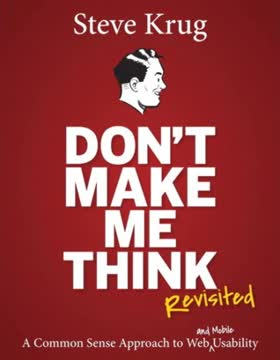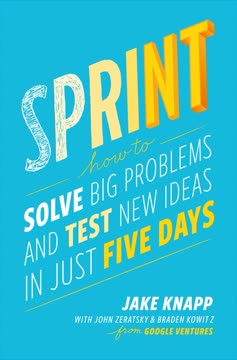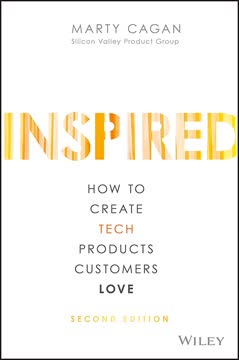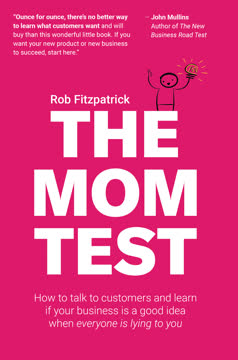重点摘要
1. 提出好问题,获得真实洞察,而非空洞赞美
《妈妈测试》:聊聊他们的生活,而不是你的想法;询问过去的具体细节,而非未来的泛泛意见;少说多听。
避免引导性问题。 与潜在客户交流时,应聚焦他们的生活、问题和过往行为,而非你的产品构想。这样能防止对方给出虚假的肯定或出于礼貌保护你的感受。不要问“你会买吗?”,而是问他们目前如何解决问题、遇到的困扰以及决策过程。
使用具体实例。 以真实的过去经历为基础展开对话,而非假设的未来。比如问“你上次遇到这个问题是什么时候?”或“请告诉我你现在是如何处理这个情况的。”这样能获得更可靠的需求和行为数据。
- 好问题示例:
- “你现在是怎么应对X的?”
- “上次发生这种情况时,能详细说说吗?”
- “你还尝试过哪些方法?”
- 坏问题示例:
- “你觉得这是个好主意吗?”
- “如果有个产品能做X,你会买吗?”
- “你愿意为X付多少钱?”
2. 避免无用数据:赞美、空话和想法
赞美是客户学习中的“愚人金”:闪亮、分散注意力,却毫无价值。
识别并回避赞美。 赞美听起来舒服,但不提供真实数据。别人说喜欢你的想法,并不代表他们会真正使用或付费。遇到赞美时,应将话题引回了解他们的问题和行为。
警惕空话和假设。 泛泛而谈、未来式承诺和假设性的“可能”都不可靠。人们往往对未来过于乐观。应关注他们当前为解决问题所做的实际行动。
- 需避免的无效数据类型:
- 赞美:“太棒了,我很喜欢!”
- 空话:“我肯定会买的。”
- 想法:没有理解根本问题的功能请求
3. 聚焦关键问题,决定业务成败
每次与人交谈,都应提出可能彻底颠覆你当前业务设想的问题。
识别关键问题。 每次对话前,明确你最需要了解的三大问题。这些问题应能否定你的商业想法或显著改变你的策略。
直面棘手问题。 不要回避预算限制、决策流程或竞争方案等潜在致命问题。及早发现这些问题,胜过投入大量时间和资源后才发现。
- 重要问题示例:
- “这笔预算来自哪里?”
- “决策还需要谁参与?”
- “如果这个问题得不到解决,会有什么后果?”
4. 保持轻松对话,获得真实反馈
了解客户及其问题,轻松随意的聊天效果胜过冗长正式的会议。
尽量避免正式会议。 轻松的对话更容易获得真诚且有价值的见解。人们在放松的环境中更愿意敞开心扉,分享真实想法。
抓住日常机会。 利用行业活动、会议或社交场合等日常机会进行相关对话,无需正式会议的压力,也能收集洞察。
- 保持轻松的技巧:
- 先聊些日常话题,再逐步引入问题
- 询问与产品相关的工作或兴趣
- 自然过渡到关键问题
- 让对话像普通聊天,而非面试
5. 寻求承诺与进展,验证兴趣
如果产品或销售会议结束后不知道下一步怎么办,会议就是徒劳。
争取具体后续行动。 每次对话结束时,争取明确的承诺或进展,比如安排后续会议、介绍决策者,甚至预订订单。
识别真实兴趣。 真正的验证来自对方愿意付出时间、金钱或声誉。单纯的赞美或模糊的未来兴趣承诺不可靠。
- 关注的承诺类型:
- 时间:同意产品演示或试用
- 声誉:介绍团队或上级
- 金钱:预订、意向书或押金
6. 找到合适的客户群体
如果你找不到持续的问题和目标,说明客户群体还不够具体。
明确理想客户。 尽可能具体地定义产品的目标用户,有助于聚焦对话,获得更一致且可操作的反馈。
进行客户细分。 从广泛群体开始,逐步缩小范围,直到找到具体且可触达的细分市场。考虑人口特征、动机和当前行为等因素。
- 客户细分问题:
- 这个群体中谁最需要它?
- 他们为什么需要?
- 他们目前如何解决这个问题?
- 我们在哪里能找到这些人?
7. 市场细分,避免信息混乱
当你对服务对象模糊不清时,会与各种不同类型的人交谈,导致信号混乱。
先聚焦,再扩展。 先专注于狭窄市场,做好后再逐步扩大,比一开始就试图服务所有人更有效。聚焦能打造真正打动特定群体的产品。
寻找一致反馈。 如果对话反馈差异巨大,说明客户群体过于宽泛。持续缩小范围,直到找到问题和目标一致的群体。
- 细分市场的好处:
- 营销信息更清晰
- 产品开发更聚焦
- 更容易找到并接触潜在客户
- 反馈更一致且可操作
8. 充分准备、复盘并做好笔记,提升客户对话效果
不知道想学什么,就没必要进行对话。
对话前做好准备。 明确当前最重要的三大问题和待验证的假设。提前了解对方或公司,避免浪费时间问显而易见的问题。
详细且有结构地记录笔记。 采用统一体系,记录痛点、目标和具体引用,方便后续复盘和团队分享。
定期复盘更新。 每次对话后,与团队一起回顾笔记,更新对客户需求的理解,调整重点问题。
- 笔记关键内容:
- 精准引用(加引号)
- 情绪反应
- 痛点与目标
- 当前解决方案及替代方法
- 提及的具体人名或公司
- 后续任务或承诺
9. 让全团队参与学习过程
由某人独揽客户对话,容易形成“客户说了算”的独裁局面。
避免学习瓶颈。 不要让客户洞察只停留在某个人手中。让创始团队全员,尤其是技术成员,参与客户对话和学习过程。
及时且忠实地分享洞察。 利用笔记和精准引用,尽快将学习成果传达给团队,保持一致认知,促进更优决策。
- 让团队参与的方法:
- 邀请不同成员参加客户会议
- 定期召开复盘会议讨论洞察
- 会后分享详细笔记和关键结论
- 鼓励团队成员提问并挑战假设
最后更新日期:
FAQ
What's "The Mom Test" about?
- Purpose of the book: "The Mom Test" by Rob Fitzpatrick is about how to have effective conversations with customers to validate business ideas without getting misleading feedback.
- Core concept: It introduces a method to ask questions that even your mom can't lie about, focusing on gathering truthful insights rather than compliments.
- Avoiding bias: The book emphasizes avoiding biased questions that lead to false positives, which can mislead entrepreneurs into thinking their idea is validated.
- Practical guide: It provides practical advice and tools from various methodologies like Customer Development and Lean Startup to improve customer conversations.
Why should I read "The Mom Test"?
- Improve customer conversations: It helps entrepreneurs learn how to talk to customers effectively to validate their business ideas.
- Avoid common pitfalls: The book addresses common mistakes in customer conversations that lead to misleading data.
- Practical advice: Offers actionable steps and real-world examples to improve the quality of feedback from customer interactions.
- Broad applicability: Useful for entrepreneurs, salespeople, mentors, and investors who want to understand customer needs better.
What are the key takeaways of "The Mom Test"?
- Ask about their life: Focus on the customer's life and past experiences rather than your idea.
- Avoid hypothetical questions: Steer clear of questions about the future or opinions, as they often lead to false positives.
- Seek commitment: Look for signs of commitment from customers, such as time, reputation, or money, to validate interest.
- Iterative learning: Continuously refine your questions and approach based on the feedback and insights gathered.
How does "The Mom Test" suggest avoiding bad data?
- Deflect compliments: Compliments are often misleading and should be deflected to focus on gathering facts.
- Anchor fluff: Avoid generic claims and future promises by anchoring questions in specific past behaviors.
- Dig beneath ideas: Understand the motivations behind feature requests or ideas rather than taking them at face value.
- Seek specifics: Always aim for concrete, specific examples from the customer's past experiences.
What is the "Mom Test" method?
- Life over idea: Talk about the customer's life instead of your idea to avoid bias.
- Specifics over generics: Ask about specific past events rather than hypothetical future scenarios.
- Listen more: Focus on listening rather than talking to gather genuine insights.
- Non-biasing questions: Craft questions that don't lead the customer to give you the answer you want to hear.
How can I apply "The Mom Test" in customer conversations?
- Prepare questions: Before conversations, prepare questions that focus on the customer's past experiences and problems.
- Keep it casual: Approach conversations informally to avoid setting expectations and biases.
- Seek advancement: Look for signs of commitment or advancement in the customer's interest.
- Review and iterate: After conversations, review notes with your team and refine your approach based on what you learn.
What are some examples of good and bad questions according to "The Mom Test"?
- Bad question: "Do you think it's a good idea?" This invites opinions and compliments rather than facts.
- Good question: "Talk me through the last time that happened." This asks for specific past experiences.
- Bad question: "Would you buy a product which did X?" This is hypothetical and often leads to false positives.
- Good question: "How are you dealing with it now?" This seeks to understand current solutions and pain points.
What are the signs of a successful meeting in "The Mom Test"?
- Facts gathered: You leave with concrete, specific facts about the customer's life and problems.
- Commitment shown: The customer shows commitment by giving up something of value, like time or money.
- Advancement achieved: The meeting ends with clear next steps or advancement in the sales process.
- Avoidance of fluff: The conversation avoids generic compliments and focuses on actionable insights.
How does "The Mom Test" suggest handling compliments and fluff?
- Deflect compliments: Politely deflect compliments to refocus the conversation on gathering useful data.
- Anchor generic claims: Ask for specific examples to anchor generic claims in reality.
- Challenge future promises: Question future promises by asking about past behaviors and current solutions.
- Focus on facts: Always steer the conversation back to concrete facts and past experiences.
What is the importance of customer segmentation in "The Mom Test"?
- Avoid drowning: Proper segmentation helps avoid being overwhelmed by too many options and mixed signals.
- Serve specific needs: Focus on a specific customer segment to tailor your product and marketing effectively.
- Consistent feedback: A well-defined segment provides consistent feedback, making it easier to validate ideas.
- Findable segments: Ensure your customer segments are specific enough to be easily found and engaged with.
How does "The Mom Test" recommend preparing for customer conversations?
- Identify big questions: Decide on the three most important questions you need answers to before the meeting.
- Research beforehand: Conduct desk research to avoid asking obvious questions and focus on deeper insights.
- Team involvement: Involve your team in preparation to ensure all perspectives are considered.
- Plan for commitment: Know what kind of commitment or advancement you want to achieve from the meeting.
What are the best quotes from "The Mom Test" and what do they mean?
- "Opinions are worthless." This highlights the importance of focusing on facts rather than opinions in customer conversations.
- "Talk about their life instead of your idea." Emphasizes the need to avoid bias by focusing on the customer's experiences.
- "The more they’re giving up, the more seriously you can take their kind words." Suggests that real commitment is shown through what customers are willing to sacrifice.
- "You aren’t allowed to tell them what their problem is, and in return, they aren’t allowed to tell you what to build." Stresses the division of responsibility between understanding the problem and creating the solution.
评论
《妈妈测试》因其关于创业者与客户对话的实用建议而备受赞誉。读者们欣赏其简明扼要、充满实例的写作风格,帮助避免客户访谈中的常见误区。书中强调应关注客户的生活和问题,而非直接推销想法。许多人认为这本书对产品开发、初创企业以及沟通技巧都有重要价值。尽管有人批评其观点过于简单,甚至可能强化刻板印象,但总体来看,它被广泛推荐为产品开发和创业领域的必读书籍,提供了切实可行的客户交流方法。
Similar Books















